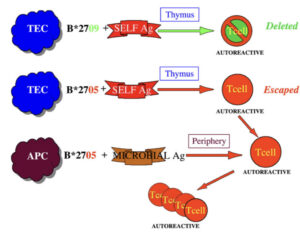Approaching the Conclusion: A Glimpse of the End for Ankylosing Spondylitis-Axial spondyloarthritis
Written by Muhammad A. Khan, MD, FRCP, MACP, Professor Emeritus of Medicine, Case Western Reserve School of Medicine, USA
This year marks the 50th anniversary of the groundbreaking discovery linking HLA-B27 to ankylosing spondylitis (AS)[1,2]. Beyond HLA-B27, over 116 additional recognised genetic risk factors have been identified, while exploration of environmental factors in this context remains limited [1,2]. Notably, HLA-B27(+) AS patients exhibit a distinct clone of potentially autoreactive (self-reactive) CD8+ T cells with TRBV9-containing T cell receptors (TCR) in their bloodstream and within inflamed tissues [2-4].

Figure 1 elucidates the persistence of autoreactive CD8+ T cells that manage to evade elimination in the thymus during early life. This phenomenon is observed in individuals born with the disease-predisposing HLA-B27 subtype (HLA-B27:05) but not in those born with the non-disease-predisposing subtype (HLA-B27:09) [3]. The proposed mechanism involves clonal expansion of these T cells upon exposure to microbial-derived peptides, followed by cross-reactivity with self-derived peptides. This cascade triggers an autoimmune inflammatory process, ultimately in AS in individuals with the disease-predisposing subtypes of HLA-B27 [3].
A recent outstanding study from a year ago has effectively unravelled the 50-year-old puzzle surrounding HLA-B27’s role in AS [5]. This breakthrough has notably expedited the potential for targeting and eliminating disease-causing T cells, offering promising prospects for curing those affected [5].
A subsequent groundbreaking paper, published a month ago, highlights the success of targeted elimination of the disease-causing TRBV9+ T cells in an HLA-B27(+) patient with AS [6]. After successful testing in nonhuman primate models, the authors observed a dramatic efficacy in elimination of these T cells in AS. The patient achieved remission within 3 months, discontinuing anti-TNF therapy used for 5 years. Complete remission has now persisted for 4 years, with three annual doses of anti-TRBV9 treatment [6].The authors aptly concluded that the selective depletion of a TRBV9-defined group of T cells presents a promising avenue for safe and effective therapies in AS. This innovative approach may extend to other HLA-B27-associated forms of spondyloarthritis [6]. Targeted elimination of the disease’s root cause, without resorting to systemic immunosuppression, holds the potential for a new era of safe and efficient autoimmune therapies.
These pivotal advancements not only signify a paradigm shift but also enhance the prospect of preventing the disease in individuals with high-genetic risk factors [5,6]. Furthermore, the discovery of enhanced biomarkers, coupled with the evolving technology of electric field molecular fingerprinting, holds promise for significantly improving early diagnosis and facilitating the initiation of curative treatments [2].REFERENCES:
-
- Braun J, Sieper J. Fifty years after the discovery of the association of HLA B27 with ankylosing spondylitis. RMD Open. 2023 Aug;9(3):e003102. doi: 10.1136/rmdopen-2023-003102.
- Khan MA. HLA-B*27 and ankylosing spondylitis: 50 years of insights and discoveries. Curr Rheumatol Rep. 2023. doi: 10.1007/s11926-023-01118-5.
- Khan MA, Mathieu A, Sorrentino R, Akkoc N. The pathogenetic role of HLA-B27 and its subtypes. Autoimmun Rev. 2007;6(3):183-9. doi: 10.1016/j.autrev.2006.11.003.
- Garrido-Mesa J, Brown MA. T cell Repertoire Profiling and the Mechanism by which HLA-B27 Causes Ankylosing Spondylitis. Curr Rheumatol Rep. 2022 Dec;24(12):398-410. doi: 10.1007/s11926-022-01090-6.
- Yang X, Garner LI, Zvyagin IV, Paley MA, Komech EA, Jude KM, et al. Autoimmunity-associated T cell receptors recognize HLA-B*27-bound peptides. Nature. 2022;612(7941):771-7. doi: 10.1038/s41586-022-05501-7.
- Britanova OV, Lupyr KR, Staroverov DB, Shagina IA, Somov DV, Klimenko A, et al. Targeted depletion of TRBV9+ T cells as immunotherapy in a patient with ankylosing spondylitis. Nat Med. Oct 23; 2023. doi: 10.1038/s41591-023-02613-z.
ID: http://orcid.org/0000-0003-4704-8311
Correspondence: m.asimkhan@gmail.com
Website: WWW.HLAB27.COM
Other NEWS

Webinar: HCP Education
Monday 19 May at 14:00-15:00 BST Register Now The global delay to …
Read More
The Pursuit of Remission and Improved Quality of Life in axSpA
Join the Global Alliance for Patient Access (GAfPA) and ASIF’s …
Read More
